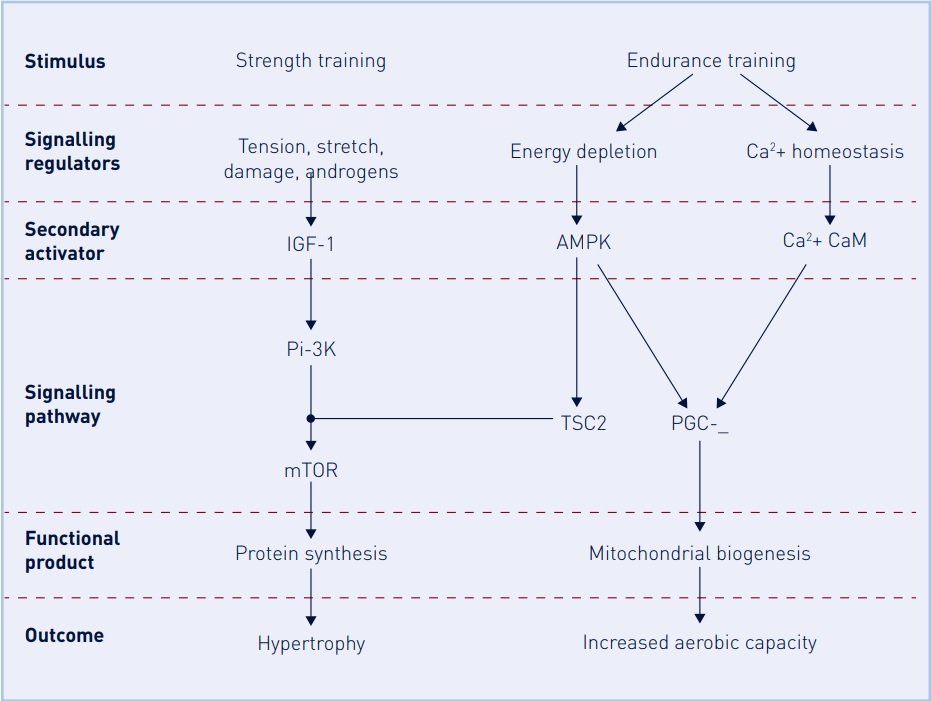by Charlie Kay
Success in sport usually requires a blend of qualities. Power, strength, speed, aerobic endurance, anaerobic endurance… the list goes on. It’s all well and good having a huge serve in tennis, for example, but you need to be able to keep hitting it for potentially hours in a match.
Rarely can you afford to focus on one individual adaptation, which means that training often follows a ‘concurrent’ approach, namely a combination of both strength/speed qualities and endurance qualities within the same programme. One potential issue with concurrent training has been apparent since Hickson (1980) and is what we term the ‘interference effect’. This refers to a difference (depending on if you are training for strength/speed or endurance qualities) in the complex cascade of hormonal responses, leading to training adaptations that for all intents and purposes are opposites of each other.
For example, after a heavy strength training session, there is a secretion of insulin-like growth factor 1 (IGF1) due to the intense muscular contractions, which causes an increase in the mammalian target of Rapamycin (mTOR) pathway. This is greatly advantageous for chasing adaptations like hypertrophy because it can upregulate protein synthesis (Blagrove, 2013). Conversely, if we were to do a long, low intensity, steady state aerobic training session, it would signal an increase in the Adenosine monophosphate-activated kinase (AMPK) pathway. This has excellent implications for increasing mitochondrial function and therefore increasing aerobic capacity. (Magness, 2014).
Okay, so far this is unnecessarily complex. Why does it matter?
The issue here is that the AMPK pathway also acts to inhibit the mTOR pathway, which will suppress the upregulation of protein synthesis caused by mTOR. Therefore, if we were to perform concurrent training we will likely ‘blunt’ the adaptations we experience, particularly those seen in strength training (Blagrove, 2014).
The bottom line – concurrent training will likely blunt adaptation, especially with strength adaptations, due to the conflicting effects of different signalling pathways. While this may not be a big problem with 99% of people training, it may be very important for those chasing marginal gains.
Here are three simple tips you can utilise in your training to limit the interference effect and maximise your gains.
1. Consolidate training stresses on the same day.
We can categorise training stresses by those which take a high and low toll on the central nervous system (CNS). High CNS activities may include sprinting, heavy strength training and anaerobic conditioning. Low CNS activities may include aerobic training and light strength training.
If we put high CNS stresses on one training day, and low CNS stresses on another day, we will be less likely to experience opposing signalling pathways.
2. Train high, train low.
Further to point 1, we know that high CNS activities take longer to recover from (around 48-72 hours) compared to low CNS activities (which only require ~24 hours). We can use this to our advantage, by training high CNS activities every 2-3 days, interspersed with low CNS activities in between. For example:
Monday – Sprints and heavy weights.
Tuesday – Steady state conditioning.
Wednesday – Plyometric and heavy weights.
Thursday – Steady state conditioning and light upper body weights.
This will enable us to maximise recovery where we can and maximise the effects of different signalling pathways.
3. If you must double up sessions on the same day, do conditioning first.
Research has shown the interference effect is lesser when we do our conditioning first, strength session second compared to the other way around. However, a slight caveat here is that we should aim to separate these sessions as much as possible (6 hours would be a good target (Blagrove, 2014), but do whatever you can). This again will help us minimise potential inteferences caused by opposing signalling pathways.

